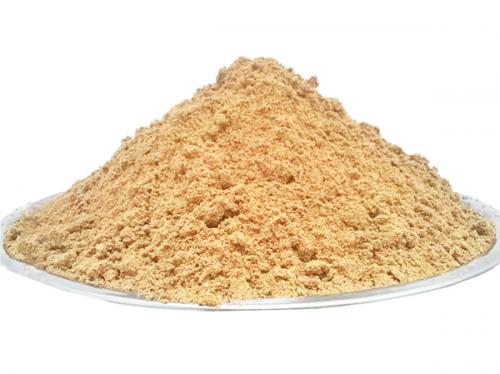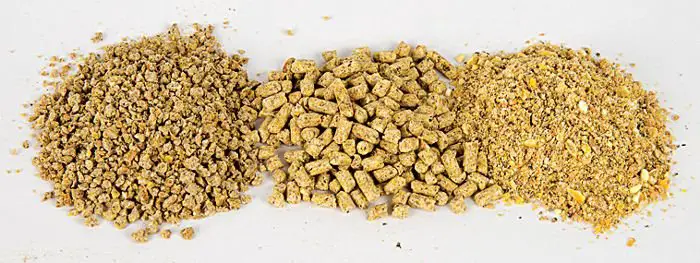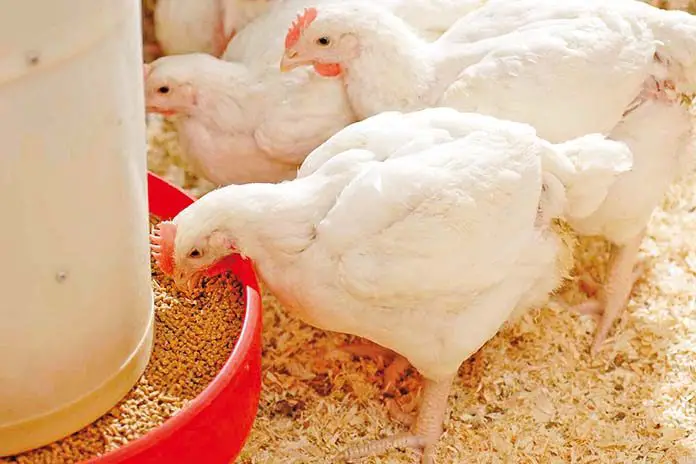Chickens are the most common domestic fowl raised in the world with an estimated number of more than 33 billion chickens across the globe. The popularity of chickens as a source of protein is mainly due to their ease of production, small footprint requirements, and ability to feed on a diverse range of feeds. Chickens can thus be raised by small-scale and commercial farmers for meat and eggs which are the primary products of chickens. Chickens are omnivores which means they can feed on feeds of both plant and animal origin. They are primarily grain feeders but will eat insects and other small creatures when foraging for food. Fish meal is an excellent source of protein in the feeding of chickens, especially in meat production where the demands for protein are higher. Fish meal is a by-product of fish processing, produced by cooking, pressing, drying, and milling the final product to produce a brown powder with a high crude protein level and omega-3 fats.
Contents
Sources of Fish Meal
Fish meal is mainly produced from small deep-sea fish like mackerel, herring, and anchovy which are also high in omega-3 fats. Reject catches, spoiled fish, offal, and trimmings from fish processing are also utilized to produce fish meal. In East Africa, the great lakes region, fish meal is produced from locally available fish species the dominant one being the silver cyprinid or omena which is sun-dried and ground to fish meal. This is also the case in other regions of the world where locally available fish species are used to make fish meal, the resultant meal quality depends on the fish or parts used and processing.
Fish Meal Nutrient Analysis
Fish meal depending on processing will have a crude protein level ranging from 62 to 70% this compared to soya with an average of 45% makes fish meal a far superior ingredient for chicken feed, also being a good source of vitamins and minerals. Fish meal is a good source of calcium and phosphorus key minerals required by chickens for growth. Choline, biotin, vitamins B12, A and E are also available in fish meal together with iodine and selenium which help boost the immune system of the chickens
Table 1: Typical Nutrient Analysis for Fish Meal
| Parameter | Unit | As Fed |
| Dry Matter | % | 92.0 |
| Crude Protein | % | 65.0 |
| Crude Fat | % | 9.20 |
| Ash | % | 16.8 |
| Gross Energy | MJ/kg | 18.9 |
| Calcium | g/kg | 44.8 |
| Phosphorus | g/kg | 28.6 |
| Sodium | g/kg | 10.5 |
| Poultry Feeding Values | ||
| AMen Broilers | MJ/kg | 13.3 |
| Available Phos Broilers | g/kg | 22.4 |
Some key parameters to check when buying fish meal for chicken feed are crude protein, ash, and dry matter. This is because some unscrupulous merchants might add water, salt, and sand to bulk up the fish meal reducing it’s quality. A high ash content for example is an indicator of sand addition in the meal. A higher salt content will also be a sign of poor processing or adulteration of the fish meal, excess salt will cause excessive water consumption and subsequently wet litter.
Inclusion Levels in Chicken Feed
The inclusion levels of fish meal in the chicken feed are limited by a number of constraints that the meal has on the chicken when used in excess amounts. In most chicken feeds fish meal is limited to not more than 5% of the total diet. One of the major reasons is that fish meal is an expensive raw material and including it at high levels makes chicken feed also expensive. Gizzerosine is a harmful chemical that is produced if fish meal is processed above 180 degrees, gizzerosine causes gizzard erosions and vomiting in chickens. The gizzard is an intergyral part of the chickens’ digestive system responsible for grinding feed, if its walls are damaged this affects feed consumption and normal digestion slowing down chicken growth. Fish meal included above 5% of the total diet will cause the meat and eggs from the chickens fed this feed to have a fishy taint that can be detected by the consumers. Because also fish meal is highly digestible it should not be fed at high levels, diets high in fish meal are used in research to induce necrotic enteritis, which is evidence working against high inclusions. Higher inclusions of fish meal have also been shown to cause wet litter which can cause leg issues like foot pad dermatitis and high ammonia levels in the chicken house affecting the performance of chickens.
Fish Meal for Broilers vs Layers
Fish meal is more valuable as an ingredient in broiler chickens than for layer birds where its inclusion is mostly in starter diets. This is mainly due to the cost of the fish meal and the fact that layers have a lower requirement for protein than broilers, especially during their adult stage their feeds can average 16% crude protein. Broilers will benefit from the high protein, calcium, and phosphorus to sustain rapid growth leading to higher kill weights in less time. Fishmeal in layer diets can help boost omega-3 levels in the eggs and hen too improving their immune system and making them less prone to diseases.
Alternatives to Fish Meal
Fish meal as mentioned above has a restricted inclusion in chicken feed hence it works better in combination with mostly soybean meal. Other high protein alternatives that can be used to feed chickens are blood meal, meat and bone meal, feather meal, and poultry by-product meal although the last two are restricted in other countries for chicken feeding. Other novel ingredients are also becoming available to replace fish meal like black soldier fly larvae, mealworms and locust and cricket meals. The availability and cost of these new ingredients is still limited so fish meal will remain a popular choice for chicken feeding now.
Properly processed fish meal is a highly digestible protein source which is also the only ingredient to provide reasonable amounts of calcium and phosphorus for chicken feeding. Together with suppling valuable omega-3 fatty acids, this makes fish meal, and almost well-rounded feed ingredient for chickens, however price and other constraints limit it use in chicken feed.




